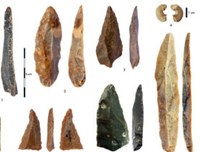The oldest "European" Homo sapiens: findings from 45,000 years ago found in Bulgaria
This is the oldest direct evidence of our species in Europe. A team led by Sarah Talamo (professor at the University of Bologna) carried out the dating of the findings thanks to a high-precision radiocarbon analysis.

In Bacho Kiro cave, Bulgaria, researchers found a fossil of Homo sapiens from more than 45,000 years ago. This is the earliest direct evidence of our species in Europe. The high-precision radiocarbon dating of the fossil was carried out by a specialised team at the head of which is Professor Sarah Talamo of the University of Bologna.
According to this discovery, the arrival of the Homo sapiens at Eurasian middle latitudes happened 2,000 years before than we had believed so far. This, as a consequence, makes the period of European co-existence between Homo Sapiens and Neanderthals considerably longer. Moreover, the recovered artefacts include some bone objects that are very similar to those produced by late Neanderthals in western Europe. This clearly confirms the theory of network and exchange, perhaps even cultural ones, that happened between the sapiens and the decaying Neanderthal population.
The outcomes of these studies - steered by scientists at the Max Planck Institute for Evolutionary Anthropology in Germany - were recently published in two papers. One, published in Nature Ecology & Evolution, focuses on the radiocarbon dating of the findings. The second paper, published on Nature, describes the new findings of the excavation campaign.
The oldest "European" sapiens
Bacho Kiro cave is a well-know archaeological site, a few kilometres from the town of Dryanovo at the foothills of the Balkan Mountains. At the beginning of the 1930s a first excavation of this site was made, then the site was re-opened in the 1970s, when some human fragments were retrieved among the findings. In 2015 a new excavation campaign took place under the joint guidance of the National Archaeological Institute of Bulgaria and the Max Planck Institute. The aim of this new excavation campaign was to deepen our knowledge of those 1970s findings and have a more precise timeline of the prehistoric human presence in that cave.
A number of new findings emerged thanks to this recent excavation campaign. Among the findings of the excavation, a tooth and five bone fragments were dug out from the upper paleolithic archeological strata and, thanks to a DNA mitochondrial analysis, were finally attributed to the species of Homo sapiens. With these new findings, it became essential to retrieve the exact timeline of the new fossils.
Two teams, professor Talamo's and Lukas Walker's (ETH, Zurich, Switzerland), analysed the human findings of the Bacho Kiro cave using an innovative approach to radiocarbon dating which allows for great precision. One of the six fossils under examination is more than 45,000 years old.
"Radiocarbon dating confirms that these fossils can be traced back to an early phase of the upper Palaeolithic and thus represent the earliest direct evidence of the presence of our species in Europe", says Professor Talamo. "These datings were made possible by a new approach to radiocarbon analysis, allowing our team to reach unprecedented levels of exactness. But there's more: Bacho Kiro's datings are part of the widest dataset from a single Palaeolithic site ever compiled by a research team".
"The animal bones found in Bacho Kiro show signs of human intervention and butchering", explains Hellen Fewlass, Professor Talamo's Ph.D. student and first author of the paper published on Nature Ecology & Evolution. "The data and the dating of human bones provide an accurate picture of the moment in which Homo sapiens started to occupy this cave, between 45.820 and 43.650 years ago, and maybe even 46.940 years ago".
"In this way, Bacho Kiro provides the evidence of the first wave of Homo sapiens who came into contact with Neanderthals and brought new behaviours to Europe", adds Jean-Jacques Hublin, head of the Max Planck Institute for Evolutionary Anthropology (Germany) e first author of the paper published on Nature. "This "sapiens" wave came largely before the one which, 8,000 years later, caused Neanderthals in western Europe to become extinct".
A long co-existence
The period of co-existence between our species and the Neanderthal Man is therefore widened of 2,000 years by the proof that Homo sapiens actually arrived in Europe before 45,000 years ago. This long co-existence must have had an impact on the evolutionary paths of the two species, as some findings from the Bacho Kiro cave seem to suggest.
Besides the human findings, some ivory and bone artefacts from the upper Paleolithic surfaced during the excavation. Researchers linked these objects to other more recent Neanderthal artefacts found in other zones of Europe.
"The ivory and bone artefacts we found in Bulgaria are remarkably similar to some other objects, discovered in the Grotte du Renne (France), that Neanderthals used to produce just before their extinction" confirms Sarah Talamo. "This similarity leads us to believe that these behaviours are the result of a close interaction between Neanderthals and the first groups of Homo sapiens in Europe" adds Jean-Jacques Hublin.
The authors of the study
The results of the latest excavation campaign of Bacho Kiro cave are collected in two papers: "Initial Upper Palaeolithic Homo sapiens from Bacho Kiro Cave, Bulgaria” was published on Nature and “A C chronology for the Middle-to-Upper Palaeolithic transition at Bacho Kiro Cave, Bulgaria” published on Nature Ecology & Evolution. A large team steered by the scientists of the Max Planck Institute for Evolutionary Anthropology in Germany coordinated the study.
Professor Sarah Talamo of the Department of Chemistry "Giacomo Ciamician" Sarah Talamo represented the University of Bologna. Professor Talamo is also Principal Investigator of the European research group RESOLUTION (ERC starting grant no. 803147). This project focuses on the development of a dataset for a high-resolution C-dating calibration so to obtain datings that can shed light on key-periods of pre-history in Europe.
